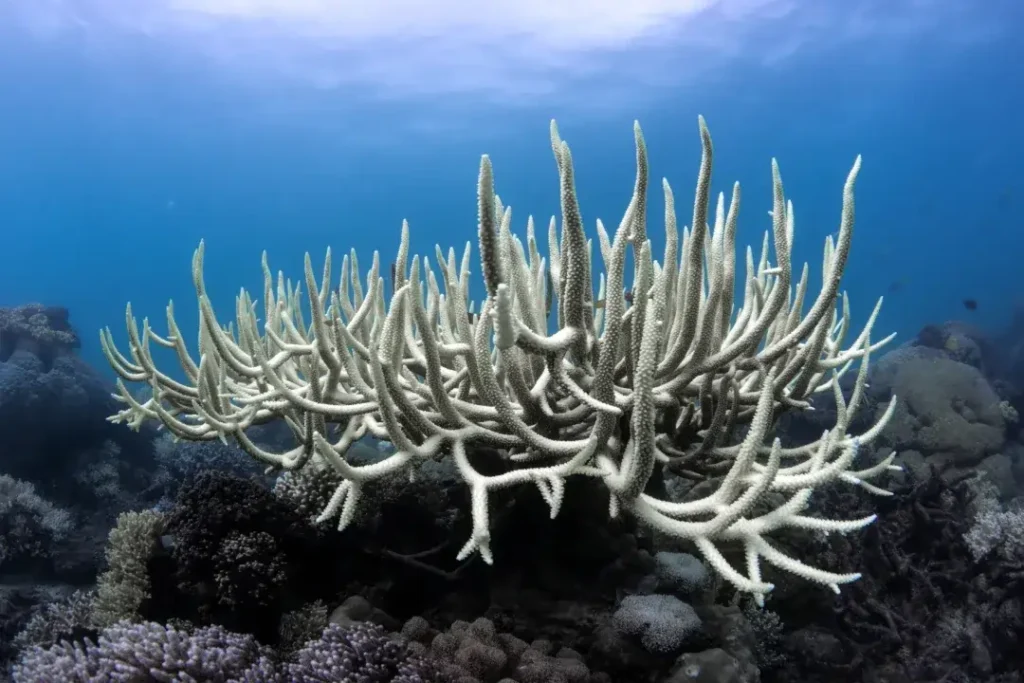⫸ Introduction to Marine Food Web
Dive into the fascinating underwater world of marine food webs! These complex networks of interconnected feeding relationships are the backbone of ocean life. Understanding marine food webs unlocks secrets about ocean ecosystems, how energy flows within them, and the delicate balance needed for the survival of countless species. Let’s explore the basics!
What is a food web?
A food web maps “who eats whom” in an ecosystem. Unlike a simple food chain, a food web shows multiple energy flow paths. This reflects the reality that most organisms have diverse diets and are both predators and prey within the web.
Key Components of a Marine Ecosystem
The Importance of Marine Food Webs
- Biodiversity: Healthy marine food webs support a vast array of life and provide the energy base for countless ocean creatures.
- Food security: Oceans are a major food source for humans.
- Climate regulation: Oceans play a key role in the global carbon cycle.
- Ecosystem Balance: Marine food webs keep populations in check, preventing overpopulation of any species.
- Nutrient Cycling: Energy and nutrients flow through the web, sustaining biodiversity.
- Global Impact: Oceans are major players in climate regulation and oxygen production, and healthy marine food webs heavily influence them.
- Resilience: Balanced food webs help ecosystems withstand disruptions.
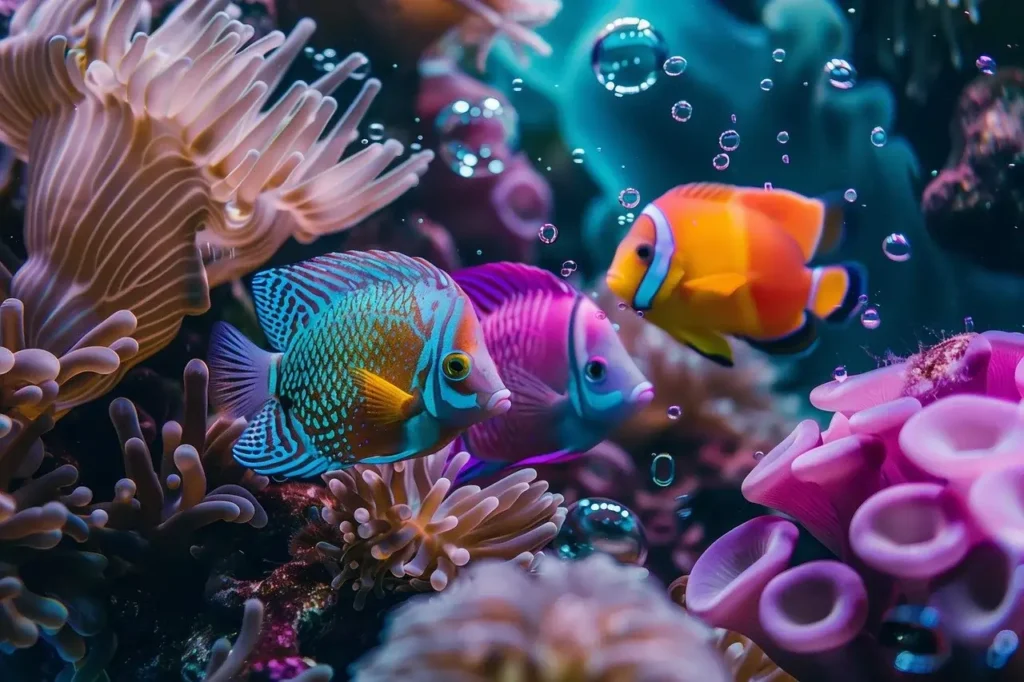
⫸ Producers: The Foundation of the Marine Food Web
Phytoplankton: Microscopic Powerhouses
Though invisible to the naked eye, phytoplankton are the giants of the marine food web. These tiny, drifting plant-like organisms use sunlight in photosynthesis to produce vast amounts of organic matter. They form the primary food source for countless marine creatures, from tiny zooplankton to massive whales.
Algae, Seaweeds, and Seagrasses: Larger Producers
Larger producers like algae, seaweeds, and seagrasses play important roles in coastal and near-shore marine food webs. Seaweeds (macroalgae) come in many forms, such as kelp forests providing food and shelter. Seagrasses, the only flowering plants in the marine world, create rich underwater meadows critical for the survival of fish, invertebrates, and even sea turtles.
The Role of Chemosynthesis in Deep-Sea Environments
While sunlight drives photosynthesis near the ocean’s surface, deep-sea environments see a different energy production system: chemosynthesis. Here, bacteria around hydrothermal vents and methane seeps use chemicals, rather than sunlight, to convert inorganic matter into food. These unique ecosystems support bizarre and fascinating creatures totally independent of the sun’s energy.
⫸ Primary Consumers: The Herbivores of the Sea
Primary consumers are the vital link in the marine food web, bridging the gap between the producers and the higher levels of the food chain. These diverse organisms are the “herbivores of the sea,” directly consuming the primary producers like phytoplankton and algae. Let’s dive into the fascinating world of these ocean herbivores:
Zooplankton: A Diverse Array of Grazers
Zooplankton may be tiny, but they are giants in the marine food web. This diverse group includes microscopic creatures like copepods and krill and the larval stages of fish, crabs, and mollusks. They spend their lives drifting with the currents, feasting on phytoplankton, and forming a crucial food source for many larger marine animals.
Benthic Invertebrates: Filter Feeders and Bottom Dwellers
The seafloor teems with benthic invertebrates that play a significant role as primary consumers. Clams, mussels, and oysters are filter feeders, straining phytoplankton from the water. Sea urchins and some snails graze on algae attached to rocks and surfaces, keeping their growth in check. These creatures are crucial in recycling nutrients on the seabed.
Larger Herbivores: Turtles and Fish
Green sea turtles are iconic ocean herbivores, their powerful jaws adapted to chomping on seagrass and algae. Some fish species are also herbivores – for instance, parrotfish use their beak-like mouths to scrape algae off coral reefs, contributing to coral health. These larger herbivores are important in controlling marine plant growth and influencing their habitats’ structure.
In the complex tapestry of the marine food web, primary consumers ensure the flow of energy from sun-powered producers up the food chain, sustaining the ocean’s incredible biodiversity.
⫸ Secondary and Tertiary Consumers: The Carnivores
These carnivores, having moved past the diet of primary producers that sustains the base of the marine food web, rely on consuming other animals for their energy needs. They are the hunters, the stalkers, and the ambush predators that keep the entire system in check, maintaining a delicate balance between predator and prey.
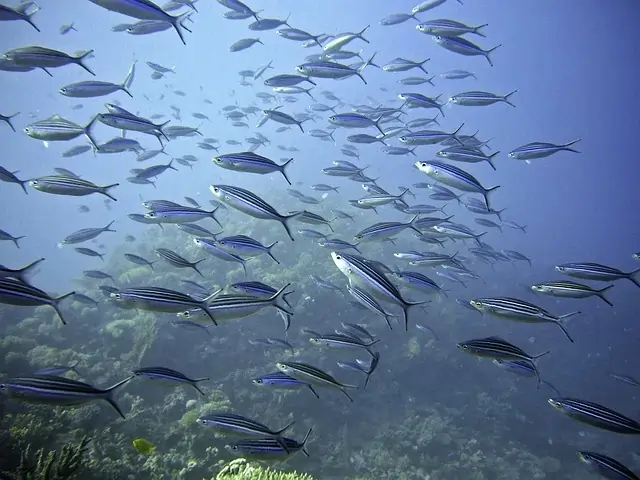
Small Fish and Cephalopods: The Link in the Chain
Vast schools of fish like sardines, herring, and agile cephalopods such as squid and octopus occupy a crucial position in the marine food web. These secondary consumers feed on zooplankton and smaller organisms, transferring energy up the chain. They are also a vital food source for larger predators, fueling the continued flow of energy.
Larger Predatory Fish: Sharks, Tuna, and More
As we move up the food chain, we encounter apex predators like sharks, tuna, marlin, billfish, and other large species. These larger fish are superbly adapted for hunting, with keen senses, powerful bodies, and specialized teeth. They target smaller fish, cephalopods, and even marine mammals, exerting a strong top-down influence on the entire marine food web. Their populations are crucial for maintaining healthy ocean ecosystems.
Marine Mammals: Dolphins, Whales, and Seals
While often portrayed as cute and cuddly, marine mammals like dolphins, whales, and seals are also formidable carnivores. Their diets vary depending on species, with some feeding on fish, squid, and krill, while others, like orcas, are apex predators that can take down large prey like sharks and seals. These air-breathing denizens of the deep play an essential role in the complex dynamics of the marine food web.
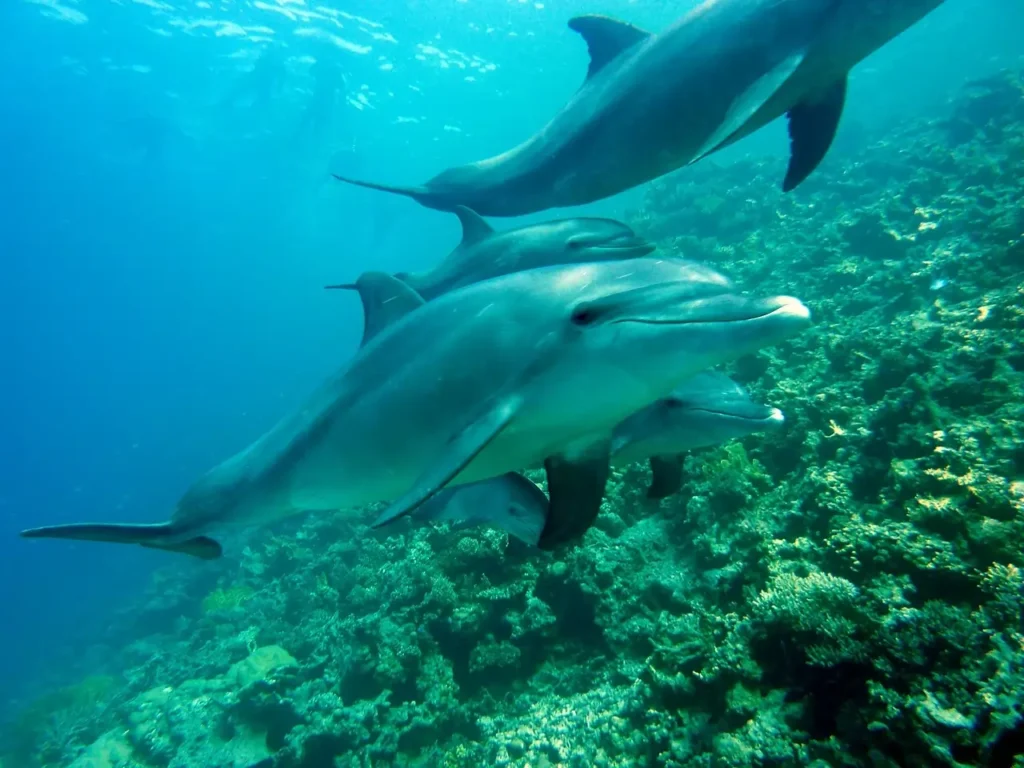
Healthy populations of secondary and tertiary consumers are essential for a balanced marine food web. These carnivores help regulate prey populations, prevent herbivores from overgrazing on vital marine life, and ensure the proper energy flow throughout the ecosystem. However, human activities like overfishing can disrupt this delicate balance, leading to cascading effects throughout the marine environment.
⫸ Apex Predators: The Top of the Food Chain
Ocean ecosystems teem with life, but at the very pinnacle of the marine food web stand the apex predators – those animals with no natural enemies of their own. These powerful creatures play a vital role in maintaining the delicate balance of marine ecosystems, ensuring populations of prey species remain in check. Let’s dive into two iconic ocean apex predators:
Sharks as Ultimate Predators
Sharks, with their streamlined bodies and rows of razor-sharp teeth, are legendary hunters. From the massive Whale Shark to the swift Tiger Shark, these predators use speed, stealth, and powerful senses to track down prey. Sharks are crucial in keeping populations of fish and marine mammals in check, preventing any one species from becoming too dominant. From smaller reef sharks to the mighty great white, sharks help shape marine ecosystems across the globe.
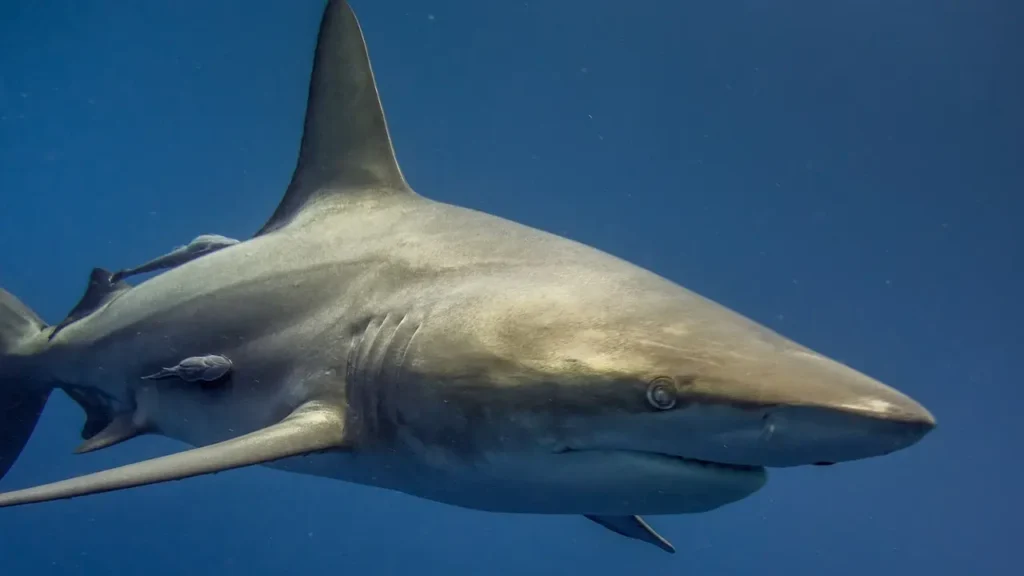
Orcas (Killer Whales): Intelligent Hunters
Orcas, or killer whales, are highly intelligent marine mammals with complex hunting strategies. Working in pods, these apex predators use sophisticated communication and teamwork to take down prey ranging from fish and seals to even other whales. Their presence at the top of the marine food web demonstrates ocean predators’ remarkable diversity and adaptability.
⫸Decomposers and the Nutrient Cycle
Often overlooked, decomposers play a vital role in the health and functioning of the marine food web. These unsung heroes ensure the continuous recycling of nutrients, making them available for the entire ecosystem. Let’s delve into how they complete the fascinating ocean life cycle.
Bacteria and fungi: Breaking down organic matter
Bacteria and fungi are the primary decomposers in marine environments. They tirelessly break down dead organisms, waste products, and other organic matter into simpler molecules. These simple molecules, like nitrates and phosphates, then act as essential nutrients for phytoplankton, the foundation of the marine food web.
The Detritus Food Chain
Detritus, organic matter broken down by decomposers, forms the basis of a unique food chain. Small invertebrates, such as worms and crustaceans, feed on detritus, which becomes food for larger organisms. This detritus food chain contributes to the immense diversity and complexity of the marine food web.
⫸Energy Transfer and Trophic Levels
Understanding energy flow is critical to grasping the dynamics of the marine food web. Let’s dive into the concepts of trophic levels, energy transfer, and how they shape the ocean’s food pyramid.
Understanding Trophic Levels
Imagine the ocean’s food web as a staircase: each step is a trophic level. Organisms occupy a specific level based on their feeding position. At the base are producers (phytoplankton, algae) converting sunlight into energy. Herbivores sit on the next step, followed by successive levels of carnivores. The topmost level houses apex predators.
Energy Flow and the 10% Rule
The catch? Only about 10% of energy gets passed up each trophic level! This means a massive phytoplankton population is needed to support a small number of apex predators. The remaining energy is lost as heat, used for movement, or remains in uneaten portions of organisms. This inefficiency is why shorter food chains are often more stable.
Food Pyramids in the Ocean
Unlike classic land-based pyramids, marine food pyramids sometimes look inverted! That’s because the massive amount of fast-reproducing phytoplankton can support a greater biomass of slightly larger herbivorous zooplankton. However, the energy transfer principle still applies, leading to fewer organisms at higher trophic levels.
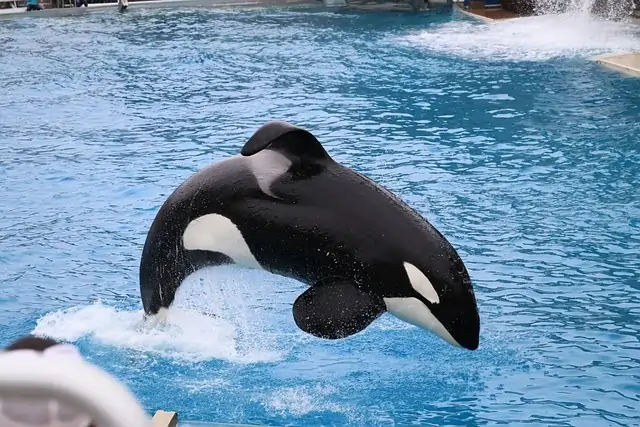
Key Points:
- The marine food web depends on energy flow from the sun to apex predators.
- Trophic levels organize the who-eats-whom system of the ocean.
- Only a small percentage of energy gets passed to the next level, leading to fewer organisms at the top of the food web.
⫸Threats to Marine Food Web
Marine food webs are facing unprecedented threats, disrupting the delicate balance of ocean ecosystems. Here’s a breakdown of some of the most critical dangers they face:
Overfishing
The unsustainable removal of fish and other marine species pushes populations beyond recovery. This disrupts the predator-prey balance within the marine food web, leading to cascading effects across the entire ecosystem. Depleting top predators can lead to explosions in populations further down, ultimately destabilizing the whole food web.

- Depletion of Key Species: When large predatory fish like tuna, sharks, and cod are overfished, the populations of smaller prey fish can explode. This unchecked growth can then deplete the resources that even smaller organisms, like zooplankton, rely on, causing a cascading effect.
- Bycatch and Ecosystem Damage: Overfishing often involves the unintended capture of non-target species, termed “bycatch”. This includes dolphins, sea turtles, and seabirds, further disrupting the marine food web. Moreover, certain fishing methods, such as bottom trawling, can physically damage the seafloor, destroying essential habitats.
Pollution and its Impacts
Marine ecosystems face an onslaught of pollution from plastics to chemicals and agricultural runoff. Human activities introduce countless pollutants into the . These pollutants can poison marine life directly, bioaccumulate in the marine food web by the process called biomagnification, or disrupt vital processes like reproduction, compromising the health and stability of entire populations.
Top predators, accumulating the highest toxin loads, often experience reproductive problems, population declines, and immune system dysfunction, disrupting the entire food web.
- Chemical Contamination: Chemicals from industrial runoff, agricultural waste, and sewage can poison marine organisms. These toxins can accumulate in fish and other animals, harming them directly or making them unsuitable for consumption by predators higher up the food chain.
- Plastic Pollution: Plastic debris is a pervasive problem in the ocean, and animals can mistake it for food. Plastic can block the digestive systems of marine life, leading to starvation or introducing harmful chemicals and microplastics into the food web.
- Nutrient Pollution: Excess nutrients from fertilizers and other sources can trigger massive algal blooms. When these blooms die off, their decomposition uses oxygen in the water, creating “dead zones” where marine life cannot survive.
Climate Change and Ocean Acidification
Rising ocean temperatures alter migration patterns, disrupt food availability, and damage sensitive habitats like coral reefs. Ocean acidification, caused by the ocean absorbing excess atmospheric CO2, weakens the shells and skeletons of key organisms in the marine food web, making them vulnerable to predators and environmental changes.
- Ocean Warming: Rising ocean temperatures force many species to migrate toward cooler waters, disrupting established food chains. Warm waters can also negatively impact crucial processes like coral reef growth, destabilizing entire ecosystems.
- Ocean Acidification: Water becomes more acidic as the ocean absorbs more carbon dioxide. This makes it difficult for organisms like shellfish and corals to build their shells or skeletons, making them vulnerable and weakening the food web base.
- Changes in Ocean Currents: Climate change alters major ocean currents, affecting the distribution of nutrients and plankton, the foundation of the marine food web. This can leave some areas impoverished while others face overabundance.
- Coral Bleaching: Elevated temperatures cause coral reefs to expel the symbiotic algae that give them their color and nutrients. Bleached reefs struggle to survive, impacting the vast network of life they support.
Coastal Development: Destroying Habitats
The alteration and destruction of coastal habitats have detrimental effects on the marine food web. Mangrove forests, seagrass beds, and coral reefs serve as vital nurseries and breeding grounds for a wide range of marine species. When these habitats are degraded or destroyed through coastal development, dredging, or pollution, many species lose the foundation they need to survive and reproduce. This loss reverberates up the food chain, affecting predators relying on these nursery species for sustenance.
Invasive Species: The Unwelcome Guests
Introducing invasive species into marine environments alters the delicate balance of the marine food web. Invasive species can outcompete native species for resources or directly prey upon them, causing population declines and even extinctions. This disruption can lead to cascading effects throughout the ecosystem, jeopardizing the stability of the entire food web.
⫸Conservation and Sustainability of the Marine Food Web
The intricate connections within the marine food web create the rich biodiversity of our oceans. However, this delicate balance faces unprecedented threats. Sustainable practices are crucial to ensure the marine ecosystem’s health and our reliance on its resources. Here’s how we can safeguard the future of our oceans:
Protecting Marine Ecosystems
Establishing protected marine areas is essential. These areas act as safe havens for marine life, allowing populations to recover and ecosystems to flourish. They also benefit the surrounding marine environments, fostering biodiversity and resilience.
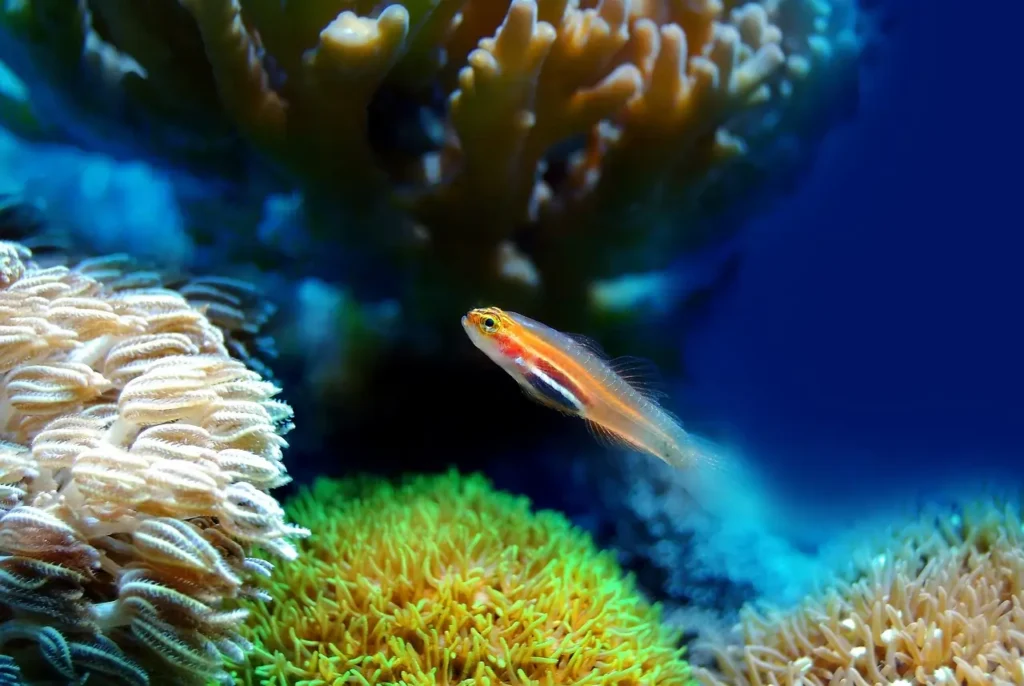
Responsible Fishing Practices
Overfishing is a major threat to the marine food web. Implementing sustainable fishing quotas, reducing bycatch (accidental capture of non-target species), and tackling illegal fishing is vital. Supporting sustainable fisheries and prioritizing long-term health over short-term gains helps maintain a balanced ecosystem.
Reducing Our Impact on the Oceans
Our choices on land directly impact the health of our oceans. Minimizing pollution through proper waste disposal and opting for eco-friendly products is essential. Reducing our carbon footprint helps combat climate change, causing ocean acidification and warming – additional pressures on the marine food web.
Let’s all play a part: By choosing sustainable seafood, supporting conservation efforts, and making conscious choices daily, we can collectively contribute to the health and longevity of the magnificent marine ecosystem.
⫸Conclusion: The Delicate Balance of the Marine Ecosystem
The ocean’s vastness might lead us to believe its resources are endless. However, the marine food web underscores the fragile interconnectedness of life beneath the waves. Each organism is vital, from the smallest phytoplankton to mighty apex predators. Disrupting this delicate balance through harmful practices like overfishing and pollution has far-reaching and often unpredictable consequences.
The interconnectedness of marine life
The marine food web is a testament to nature’s intricate design. A decline in phytoplankton populations can reduce food sources for countless species, eventually impacting even top predators. Likewise, removing apex predators can cause a cascade of effects down the food web, leading to ecological imbalances.
The importance of conservation efforts
Recognizing the vital link between a healthy marine food web and the well-being of our planet, conservation efforts are paramount. Supporting sustainable fishing practices, reducing pollution, and protecting marine habitats are essential. Our choices, both as individuals and collectively, have the power to safeguard the delicate balance of the marine ecosystem for generations to come..


